Earlier this month I attended the 18th International Conference on Social Dilemmas. The conference was a great experience and I would highly recommend it if you are interested in the social dilemmas' research field. During the 2nd day of the conference and after having sat in many of the talks there was something I started to notice. That was that all the speakers, including female speakers, had mainly only male collaborators and even if a speaker had a female collaborator then it would be just one.
I am an example of this. At the conference I presented a piece of work that I conducted with my collaborators, and all three of them are men. So I started to wonder: Do female researchers publish alone? And more specifically do female Mathematicians publish together? So in this post I am going to try and answer the following question:
Are there publications in Mathematics written only by women?
Collecting Data
To explore the question the first thing that is needed is data. In order to collect meta data on publications I am using an open source package, to which I am a maintainer, called Arcas.
Using the library I can collect data from arXiv, Springer and IEEE on the topic of Mathematics. If you are interested in the code for collecting the data it can be found here (in the form of a Jupyter Notebook).
Determining the Authors’ Gender
Using Arcas a total of 19280 Math articles have been collected. Arcas returns a series of meta data but most of them are ignored for the purpose of this post. The meta data of interest here are the unique key (which will allows us to differentiate between articles), the year of publication, the names of the authors, the title of the article and the source (arXiv, Springer or IEEE).
An author's name consists of the author's forename and surname. To determine the
gender of the author I am using a Python package called
gender_guesser.
Gender_guesser is an open source package which verifies gender based on the forename!
The package it's based on the program "gender" by Jorg Michael and its
use is pretty straightforward:
>>> import gender_guesser.detector as gender
>>> d = gender.Detector(case_sensitive=False)
>>> d.get_gender('nikoleta')
'female'The result of d.get_gender can be one the following:
unknown(name not found),andy(androgynous),male,female,mostly_male,mostly_female.
Now that the gender of the authors has been “determined” there are 3 extra measures left to introduce. The number of authors per article, the ratio of female authors \(\frac{\text{#female} + \text{#mostly_female}}{\text{#authors}}\) per article and the ratio of male authors \(\frac{\text{#male} + \text{#mostly_male}}{\text{#authors}}\).
Now that all the measures have been presented we can proceed to the analysis. Note that the data is archived and available here.
Analysis
There are a total of 28404 different authors within the data set. There are authors with multiple entries/papers. Out of the 28404 authors 10991 of them have been identified as males and 482 as mostly males. A total of 2168 have been identified as females and 186 as mostly females. There are 10144 authors whose gender is unknown and it will be left as it is. I would like to avoid making any further assumptions regarding the authors' gender.
| Gender | Count in data |
|---|---|
| mostly_female | 186 |
| mostly_male | 482 |
| female | 2168 |
| andy | 3584 |
| unknown | 10144 |
| male | 10991 |
Thus, approximately 11473 authors within the data set are men and 2354 are women. This indicates a substantial gender gap in mathematics publications. For every female author there are 5 male ones.
Mathematics is a field known to be suffering from gender inequality. For example only one woman, Maryam Mirzakhani, has won the Fields Medal in the field and less than 30% of all U.S. doctoral degrees in mathematics and statistics are awarded to women (source). It is important to note that actions are being taken to encourage women employment in higher education and research positions in Mathematics. One example of this is Athena SWAN in the UK.
Figure 1 shows the mean number of female authors over the years. Though there were not many female authors before 2010 there seems to be an increase in numbers since then.
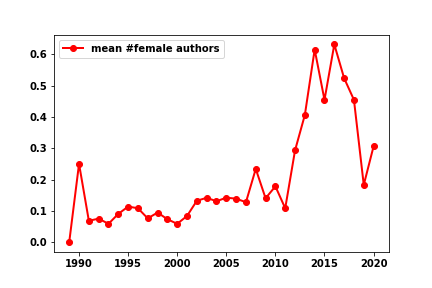
Let's explore the gender ratios and more specifically their distributions. The summary statistics of the distributions are given by the table below, and the normalised distributions are also shown in Figure 2.
| Gender | Female Ratio | Male Ratio |
|---|---|---|
| mean | 0.072 | 0.497 |
| std | 0.210 | 0.447 |
| min | 0.000 | 0.000 |
| 25% | 0.000 | 0.000 |
| 50% | 0.000 | 0.500 |
| 75% | 0.000 | 1.000 |
| max | 1.000 | 1.000 |
There is a significant difference (p value\(=0.0\)) between the two distributions as can be seen in the plots of the distributions.
The are two main conclusions that can be made from the ratio distributions. These are that 50% of the publications have a male ratio of 0.5 or above and, 75% of the publications have no female authors.
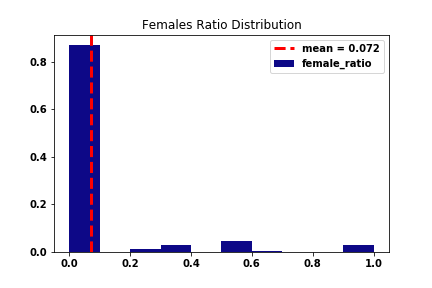
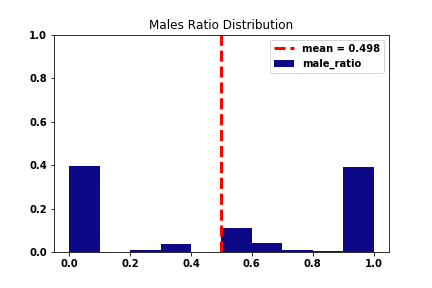
There are however publications that include women authors 🎉. To gain a better understanding of the papers that do have female authors the female ratio distribution is plotted once again, but this time the values of 0 have been excluded. This is shown in Figure 3.
So there are indeed articles written only by women. It is most common however, that if a paper has women authors that, on average, they make up the half of the authors.
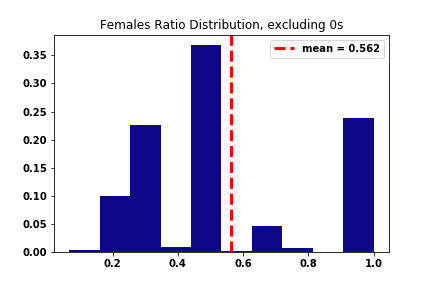
The papers that have been written by only female authors can also be further
examined. The number of authors per paper, written only by women, is shown
in the following table:
| Number of Authors of papers written by women (female ratio = 1) | Count | Percentage |
|---|---|---|
| 1 | 457 | 77.72 |
| 2 | 117 | 19.90 |
| 3 | 12 | 2.04 |
| 4 | 1 | 0.17 |
| 7 | 1 | 0.17 |
78% of the papers written only by women are written only by a single woman. 117 articles have each been written by 2 women and 12 by 3. There is however a paper with 7 women authors and that is the article "Modular invariants for genus 3 hyperelliptic curves" written by Sorina Ionica, Pinar Kilicer, Kristin Lauter, Elisa Lorenzo Garcia, Maike Massierer, Adelina Manzateanu and Christelle Vincent.
For comparison, the same table is given for male authors. Though similarly a big percentage of papers written only by men have been written by a single man, approx 60%, the interesting difference appears to be in papers with 3 to 5 authors. Almost 8% of the publications written by only men, have been written by 3 authors. On the other hand only 2% of the publications written by women have 3 authors. That is 12 articles compared to 589. Similar observations can be made for papers with 4 and 5 authors. There are hardly any with only female authors.
| Number of Authors of papers written by men (male ratio = 1) | Count | Percentage |
|---|---|---|
| 1 | 4545 | 60.40 |
| 2 | 2244 | 29.82 |
| 3 | 589 | 7.82 |
| 4 | 125 | 1.66 |
| 5 | 14 | 0.19 |
| 6 | 7 | 0.09 |
| 8 | 1 | 0.01 |
Summary
In summary, in this post I have tried to present some data that allow us to understand publications in the field of Mathematics, and more specifically the inequality between the authors' gender.
There are significantly less women publishing in Mathematics than men. More specifically every woman author corresponds to 5 males ones and 75% of the articles we have gathered (automatically) do not have a single female author. Women mathematicians do however exist, I am also a proof!, and they do publish.
If a papers has female authors then they are more likely to make up half of the authors, and there are also publications that are solitarily by women. However, there are significantly less publications made by teams of 3 to 5 women compared to men.
The difference between gender publications has also been examined over the different sources used in this post, arXiv, Springer and IEEE, and there appears to be no significant effect based on the source.
Though the number of women in Mathematics in research positions are increasing and publications are made with other collaborators, there appears to be a boundary that makes collaborations of a large group of only women hard. There are several causes that could be influencing this effect, though I can only make speculations to this point,
- The low ratio of women to men. Mathematics is an enormous field and with such a low ratio of women to men finding women in your field could be a task.
- Journals can be biased.
- Anyone is more likely to publish if one of the named authors is “famous”. The probability of an author being famous is higher if they are a man.
- Men reviewers are more likely to accept articles written by men and most reviewers are men. Thus you are more likely as a woman to publish if you have another man co author.
Comparison to Psychology
So there is clearly an issue with gender equality in Mathematical publications. Though I have not yet identified the cause of the effect, that might end up being a future post, many might wonder: are not all fields similar? So let's compare the gender ratios to another field.
I originally came up with the idea while sitting in a series of talks given by Psychologists. So it only seems fair to collect data in Psychology. Note that arXiv does not have papers in Psychology so data have been collected only from IEEE and Springer. There a total of 10169 articles within the new data, and a total of 23740 unique authors. The gender ratio distributions are given by Figure 4.
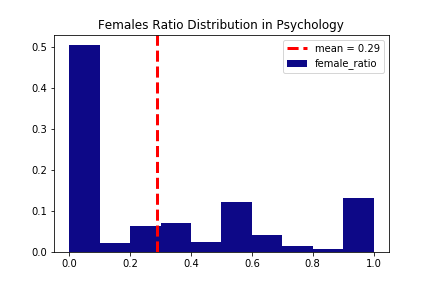
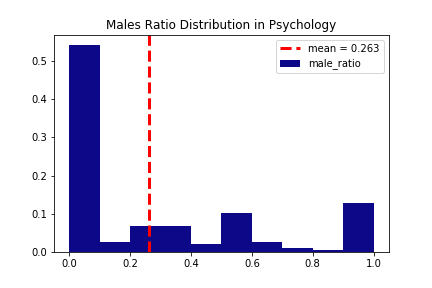
It’s hard to tell the difference between them right? Hopefully the ratios for Math publications will be the same in the near future.
If you are interested in the topic of gender inequality, gender stereotypes and how questionable science has been fueling the gender gap I highly recommend the book Inferior written by, one of my favourite authors, Angela Saini.
Finally, the source code used for this post is available on GitHub: